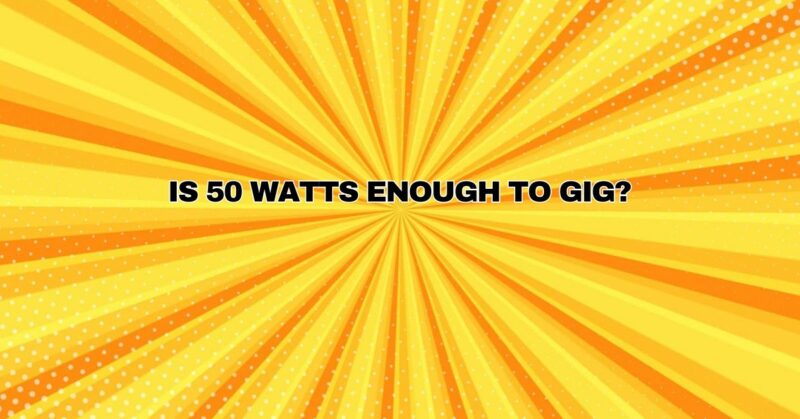When it comes to choosing a guitar amplifier for gigging, the question of wattage often looms large. In this article, we’ll explore the concept of amplifier wattage, its impact on live performances, and whether a 50-watt amp is enough to handle the demands of gigging in various settings.
Understanding Amplifier Wattage
Amplifier wattage is a measure of the amplifier’s power output, and it plays a pivotal role in determining how loudly an amp can project sound. The relationship between wattage and volume isn’t linear but logarithmic, which means that it takes a substantial increase in wattage to double the perceived volume. For example, a 50-watt amp isn’t merely twice as loud as a 25-watt amp; it’s significantly louder.
Factors Influencing Wattage Adequacy
Whether a 50-watt amp is sufficient for gigging depends on several crucial factors, including:
- Venue Size: The size of the venue is a primary consideration. In smaller clubs, bars, and intimate settings, a 50-watt amp can often provide ample volume. However, for larger venues or outdoor stages, more wattage may be required to ensure your guitar is heard throughout the audience.
- Genre and Style: The musical genre you play and your playing style influence the necessary wattage. For genres requiring clean tones, such as jazz or country, a 50-watt amp may be more than sufficient. In contrast, high-gain genres like hard rock and metal may necessitate more wattage to maintain clarity and projection.
- Amplifier Design: The design of the amplifier, including the type of tubes (if it’s a tube amp), speaker size, and efficiency, affects how effectively it delivers sound. A 50-watt amp with a large and efficient speaker can produce more volume than one with a smaller, less efficient speaker.
- Mic’ing and PA Systems: In many gigging scenarios, amplifiers are mic’d and routed through a PA (public address) system. When mic’d, even a 50-watt amp can provide sufficient volume, as it primarily serves as stage monitoring while the PA system takes care of the front-of-house sound.
Types of 50-Watt Amplifiers
There’s a wide range of 50-watt amplifiers available, each with its unique features and tonal characteristics. Here are a few notable examples:
- Marshall DSL40CR (40W/20W): While technically 40 watts, the DSL40CR offers selectable wattage settings and is a versatile tube amp known for classic Marshall tones.
- Fender Hot Rod Deluxe IV (40W): Another 40-watt tube amp known for its clean tones and excellent versatility, often used by blues, rock, and country players.
- Orange Rocker 50 (50W): A classic British-made 50-watt tube amp with a reputation for delivering powerful, gritty tones suitable for rock and metal genres.
- Blackstar HT Stage 60 (60W): Slightly above the 50-watt mark, this versatile tube amp offers various tonal options and wattage settings to adapt to different gigging scenarios.
Making the Most of 50 Watts
To maximize the potential of a 50-watt amp for gigging, you can consider the following strategies:
- Speaker Efficiency: Invest in a high-efficiency speaker cabinet to ensure that your 50-watt amp’s output is effectively translated into sound.
- Pedalboard: Utilize boost, overdrive, and distortion pedals to help your 50-watt amp reach higher gain levels, making it louder and more suitable for high-energy performances.
- Mic’ing and PA Systems: When playing in larger venues, always consider mic’ing your amplifier and routing it through a PA system to ensure even coverage throughout the audience.
- Volume Control: Learn to manage your amp’s volume effectively to balance your sound with other instruments on stage without overpowering the mix.
Conclusion
In conclusion, the suitability of a 50-watt amp for gigging hinges on various factors, including the venue size, musical genre, amplifier design, and the context in which you’re performing. A 50-watt amp can be more than enough for many gigging situations, especially in smaller to medium-sized venues where clean and slightly overdriven tones are the norm. However, for genres demanding high-gain and louder stage volumes, you may need additional wattage or support from PA systems to ensure your guitar cuts through the mix effectively.
Ultimately, choosing the right amplifier wattage involves understanding your specific gigging needs, tonal preferences, and the venues you’ll be playing in. It’s essential to strike a balance between power and practicality to ensure that your 50-watt amp can meet the demands of your live performances while delivering the sonic qualities that align with your musical style.


